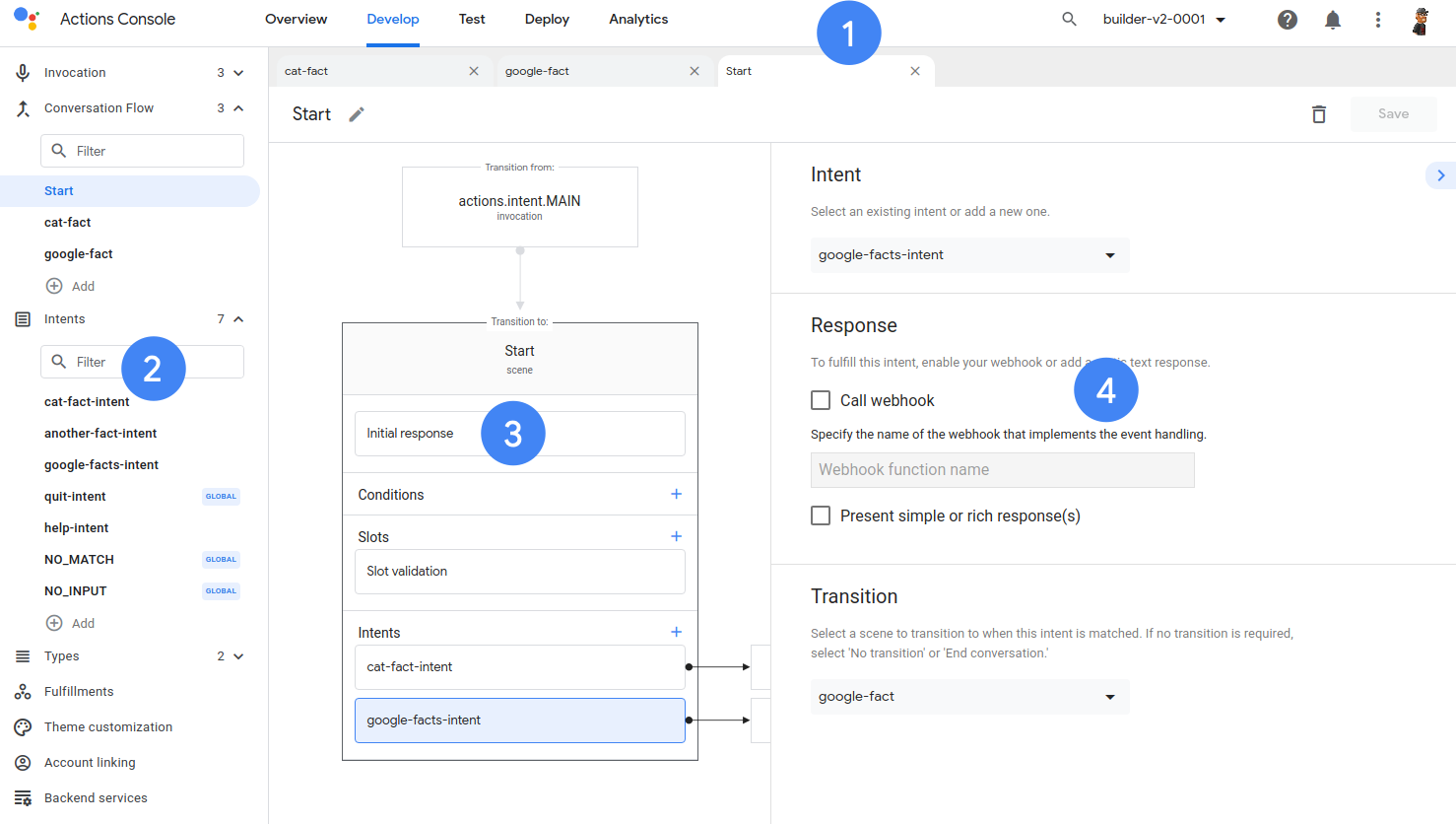หากต้องการสร้างการดำเนินการแบบการสนทนา คุณต้องสร้างและติดตั้งใช้งานคอมโพเนนต์ต่อไปนี้
- โปรเจ็กต์ Actions - คอนเทนเนอร์เชิงตรรกะสำหรับ Conversational Actions, บริการเว็บ และเว็บแอปทั้งหมด นอกจากนี้ยังกำหนดการตั้งค่าและทรัพยากรของโปรเจ็กต์ที่อธิบายวิธีทำให้โปรเจ็กต์ใช้งานได้ใน Actions on Google
- รูปแบบการเรียกใช้ - กำหนดวิธีที่ผู้ใช้ค้นพบและเริ่ม Actions ภายในโปรเจ็กต์ คุณสร้างโมเดลการเรียกใช้ด้วยIntent และประเภท
- โมเดลการสนทนา - กำหนดสิ่งที่ผู้ใช้พูดกับ Actions ของคุณได้ และวิธีที่ Actions ตอบกลับผู้ใช้ คุณสร้างโมเดลการสนทนาด้วยเจตนา ประเภท ฉาก และพรอมต์
- Webhook - การดำเนินการสามารถทริกเกอร์ Webhook เพื่อมอบหมาย ตรรกะเพิ่มเติมให้กับบริการจัดการคำสั่งซื้อ เช่น การสร้างพรอมต์ การตรวจสอบข้อมูล และอื่นๆ
- Canvas แบบอินเทอร์แอกทีฟ - คุณสามารถแสดงเว็บแอปแบบอินเทอร์แอกทีฟเต็มหน้าจอที่ขับเคลื่อนด้วย HTML, CSS และ JavaScript แทนการส่งการตอบกลับเป็นข้อความธรรมดาหรือริชการ์ดและรูปภาพ
ส่วนต่อไปนี้จะอธิบายเครื่องมือที่คุณจะใช้สร้าง Actions
การทำงาน
Actions API คือชุดเครื่องมือสำหรับนักพัฒนาซอฟต์แวร์ที่ใช้สร้าง Actions สำหรับ Google Assistant โดยประกอบด้วยฟีเจอร์ต่อไปนี้
การแสดงโปรเจ็กต์ Actions แบบเปิดที่อิงตามไฟล์ - สร้างโมเดลการเรียกใช้และการสนทนาด้วยIntent, ประเภท, ฉาก และพรอมต์ คุณแก้ไขโปรเจ็กต์ Actions ด้วยโปรแกรมแก้ไขข้อความที่ชื่นชอบ เช็คอินลงในระบบควบคุมแหล่งที่มา สร้าง กระบวนการอัตโนมัติ และอื่นๆ ได้
อินเทอร์เฟซบรรทัดคำสั่ง (CLI) - เครื่องมือ
gactionsมี CLI สำหรับการเริ่มต้นและ การพัฒนา Actions โดยอัตโนมัติ ซึ่งช่วยให้คุณเริ่มต้นไฟล์โปรเจ็กต์ Action มาตรฐาน, พุชการอัปเดตไปยังคอนโซล Actions, ทำให้โปรเจ็กต์ Action ใช้งานได้ และอื่นๆ เครื่องมือนี้ช่วยให้คุณทำเวิร์กโฟลว์ทั่วไปได้หลายอย่าง เช่น การนำเข้า โปรเจ็กต์ที่มีอยู่ หรือเริ่มทำงานในฟีเจอร์สาขาโดยใช้ระบบควบคุมแหล่งข้อมูลที่คุณชื่นชอบActions API - Actions API เป็น API เดียวกับที่เครื่องมือ
gactionsใช้ Actions API มีรายการปลายทาง REST เพื่อ จัดการ Actions รวมถึงสำหรับการทดสอบและการสร้าง API ช่วยให้คุณใช้คำขอ JSON เพื่อดำเนินการเวิร์กโฟลว์ทั่วไปหลายอย่างได้ เมื่อใช้ Actions API คุณควรพิจารณาขีดจํากัดและแนวทางปฏิบัติแนะนําบางอย่างWebhook และไลบรารีการดำเนินการตามคำสั่ง Node.js - Actions ของคุณสามารถมอบหมายตรรกะทางธุรกิจให้กับบริการเว็บด้วย Webhook และรูปแบบการรับส่งข้อความที่อิงตาม JSON เรามีไลบรารีการจัดการคำสั่งซื้อ Node.js ซึ่งมีอินเทอร์เฟซที่เหมาะสมสำหรับ Webhook ของการสนทนา ไลบรารีนี้ช่วยให้ ติดตั้งใช้งานโฟลว์ของผู้ใช้ทั่วไปหลายรายการได้ง่าย ตัวอย่างเช่น ฟีเจอร์บางอย่างรวมถึง การแยกพารามิเตอร์จากคำค้นหาของผู้ใช้และการสร้างประสบการณ์มัลติโมดอล (เสียงเท่านั้นและเสียงพร้อมภาพ) สำหรับ Google Assistant
เครื่องมือสร้างการดำเนินการ
Actions Builder มี IDE บนเว็บที่ทรงประสิทธิภาพและใช้งานง่าย ซึ่งผสานรวมเข้ากับคอนโซล Actions เนื่องจาก Actions Builder สร้างขึ้นจากเทคโนโลยีเดียวกับ Actions API คุณจึงใช้ Actions Builder เพียงอย่างเดียวหรือใช้ร่วมกับ Actions API ก็ได้ตามความต้องการ

UI ของ Actions Builder แบ่งออกเป็นส่วนต่างๆ ดังนี้
- เมนูด้านบนช่วยให้เข้าถึงส่วนต่างๆ ของคอนโซล Actions ได้ และคุณเข้าถึง Actions Builder ได้ในแท็บพัฒนา
- เมนูด้านซ้ายช่วยให้คุณเข้าถึงคอมโพเนนต์ทั้งหมดเพื่อสร้าง Actions เช่น Intent และฉาก
- พื้นที่สร้างช่วยให้คุณสร้างคอมโพเนนต์ที่กำลังทำงานอยู่ได้
- พื้นที่รายละเอียดช่วยให้คุณกำหนดรายละเอียดเพิ่มเติมเกี่ยวกับคอมโพเนนต์ที่กำลัง ทำงานอยู่ได้

